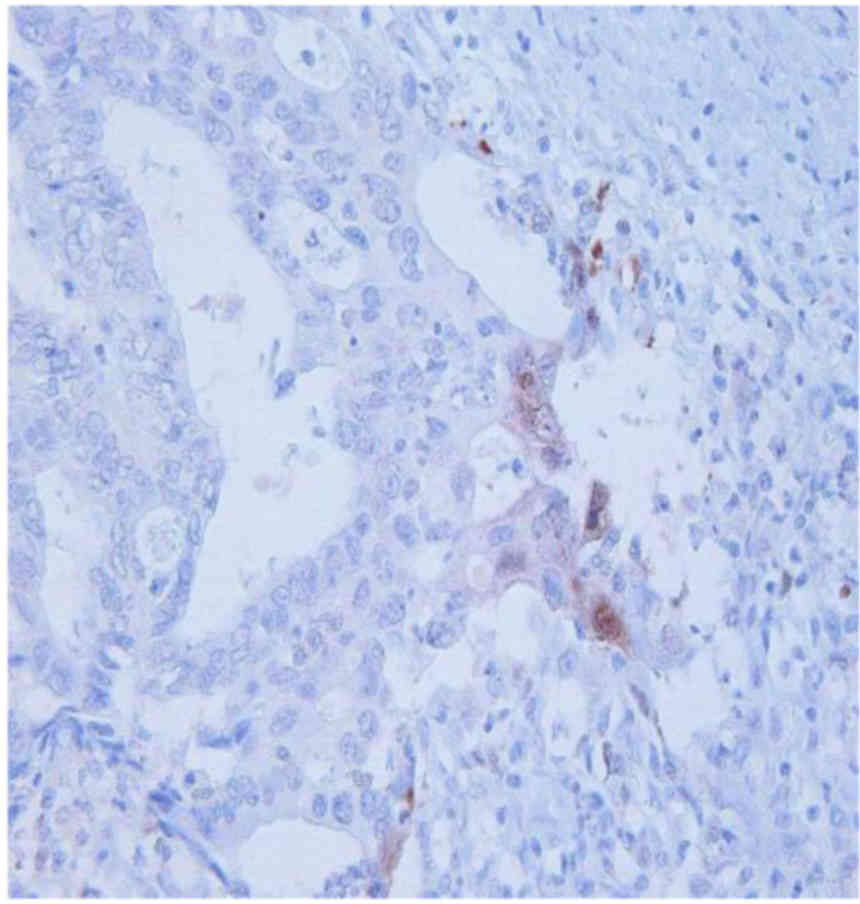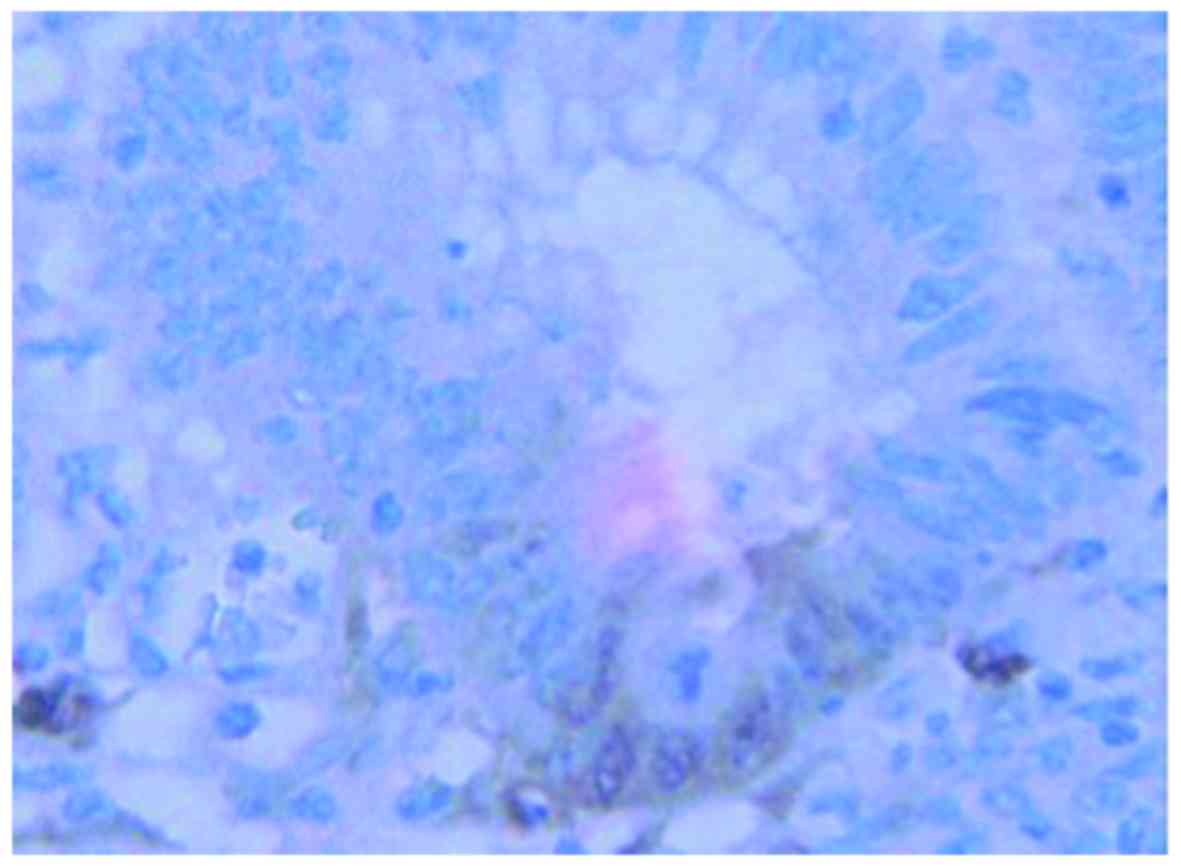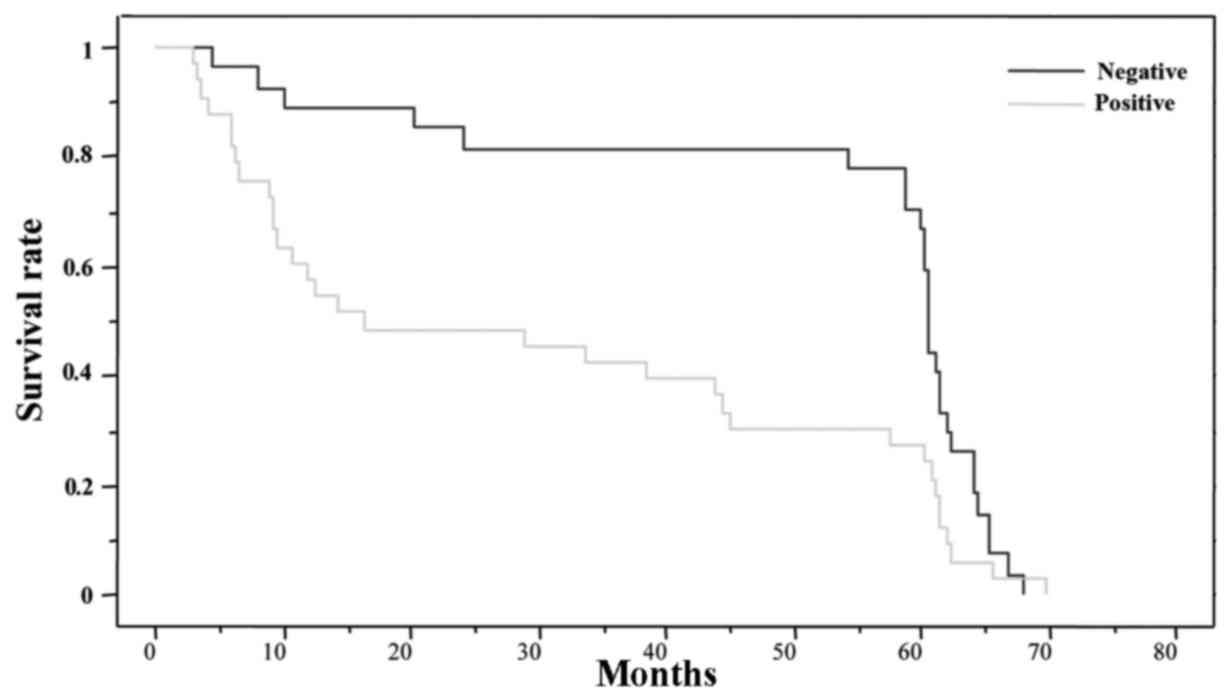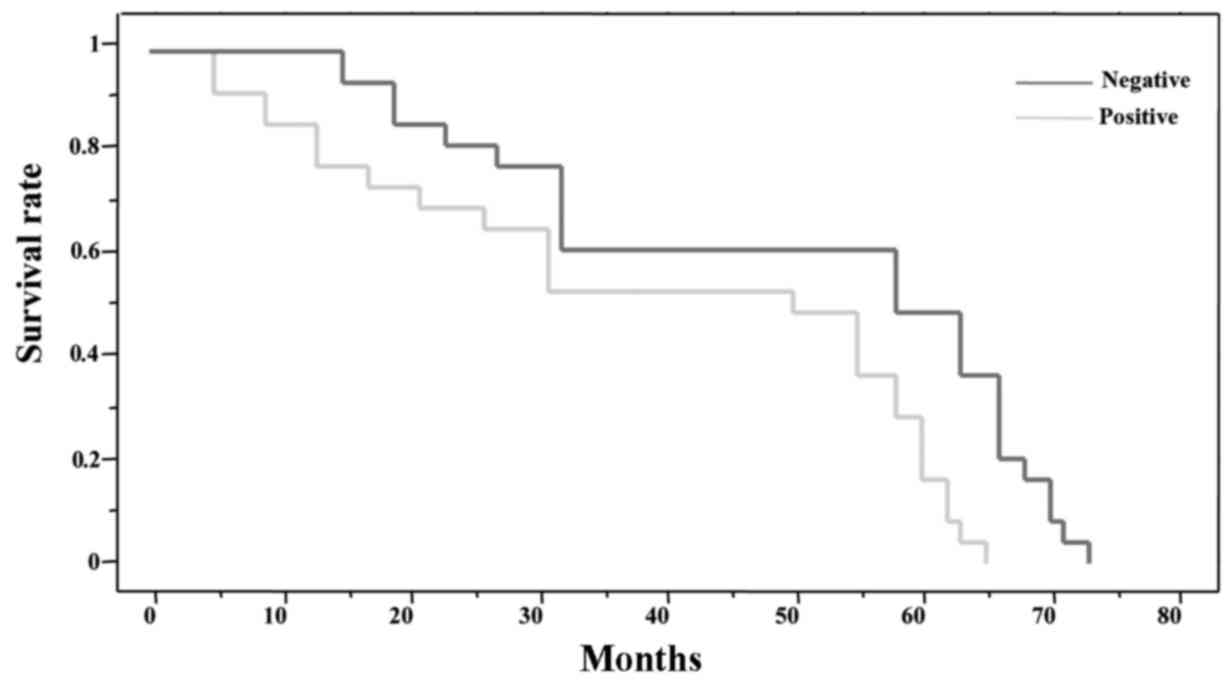|
1
|
Weitz J, Koch M, Debus J, Höhler T, Galle
PR and Büchler MW: Colorectal cancer. Lancet. 365:153–165. 2005.
View Article : Google Scholar : PubMed/NCBI
|
|
2
|
Jemal A, Murray T, Ward E, Samuels A,
Tiwari RC, Ghafoor A, Feuer EJ and Thun MJ: Cancer statistics,
2005. CA Cancer J Clin. 55:10–30. 2005. View Article : Google Scholar : PubMed/NCBI
|
|
3
|
Caruz A, Samsom M, Alonso JM, Alcami J,
Baleux F, Virelizier JL, Parmentier M and Arenzana-Seisdedos F:
Genomic organization and promoter characterization of human CXCR4
gene. FEBS Lett. 426:271–278. 1998. View Article : Google Scholar : PubMed/NCBI
|
|
4
|
Kucia M, Jankowski K, Reca R, Wysoczynski
M, Bandura L, Allendorf DJ, Zhang J, Ratajczak J and Ratajczak MZ:
CXCR4-SDF-1 signalling, locomotion, chemotaxis and adhesion. J Mol
Histol. 35:233–245. 2004. View Article : Google Scholar : PubMed/NCBI
|
|
5
|
Saini V, Marchese A and Majetschak M: CXC
chemokine receptor 4 is a cell surface receptor for extracellular
ubiquitin. J Biol Chem. 285:15566–15576. 2010. View Article : Google Scholar : PubMed/NCBI
|
|
6
|
Chambers AF, Groom AC and MacDonald IC:
Dissemination and growth of cancer cells in metastatic sites. Nat
Rev Cancer. 2:563–572. 2002. View
Article : Google Scholar : PubMed/NCBI
|
|
7
|
Zeelenberg IS, Ruuls-Van Stalle L and Roos
E: The chemokine receptor CXCR4 is required for outgrowth of colon
carcinoma micrometastases. Cancer Res. 63:3833–3839.
2003.PubMed/NCBI
|
|
8
|
Kim J, Takeuchi H, Lam ST, Turner RR, Wang
HJ, Kuo C, Foshag L, Bilchik AJ and Hoon DS: Chemokine receptor
CXCR4 expression in colorectal cancer patients increases the risk
for recurrence and for poor survival. J Clin Oncol. 23:2744–2753.
2005. View Article : Google Scholar : PubMed/NCBI
|
|
9
|
Kawada K, Hosogi H, Sonoshita M, Sakashita
H, Manabe T, Shimahara Y, Sakai Y, Takabayashi A, Oshima M and
Taketo MM: Chemokine receptor CXCR3 promotes colon cancer
metastasis to lymph nodes. Oncogene. 26:4679–4688. 2007. View Article : Google Scholar : PubMed/NCBI
|
|
10
|
Zipin-Roitman A, Meshel T, Sagi-Assif O,
Shalmon B, Avivi C, Pfeffer RM, Witz IP and Ben-Baruch A: CXCL10
promotes invasion-related properties in human colorectal carcinoma
cells. Cancer Res. 67:3396–3405. 2007. View Article : Google Scholar : PubMed/NCBI
|
|
11
|
Cambien B, Karimdjee BF, Richard-Fiardo P,
Bziouech H, Barthel R, Millet MA, Martini V, Birnbaum D, Scoazec
JY, Abello J, et al: Organ-specific inhibition of metastatic colon
carcinoma by CXCR3 antagonism. Br J Cancer. 100:1755–1764. 2009.
View Article : Google Scholar : PubMed/NCBI
|
|
12
|
Kawada K and Taketo MM: Significance and
mechanism of lymph node metastasis in cancer progression. Cancer
Res. 71:1214–1218. 2011. View Article : Google Scholar : PubMed/NCBI
|
|
13
|
Moffett JR and Namboodiri MA: Tryptophan
and the immune response. Immunol Cell Biol. 81:247–265. 2003.
View Article : Google Scholar : PubMed/NCBI
|
|
14
|
Yoshida R, Urade Y, Tokuda M and Hayaishi
O: Induction of indoleamine 2,3-dioxygenase in mouse lung during
virus infection. Proc Natl Acad Sci USA. 76:4084–4086. 1979.
View Article : Google Scholar : PubMed/NCBI
|
|
15
|
Yoshida R and Hayaishi O: Induction of
pulmonary indoleamine 2,3-dioxygenase by intraperitoneal injection
of bacterial lipopolysaccharide. Proc Natl Acad Sci USA.
75:3998–4000. 1978. View Article : Google Scholar : PubMed/NCBI
|
|
16
|
Pfefferkorn ER: Interferon gamma blocks
the growth of Toxoplasma gondii in human fibroblasts by inducing
the host cells to degrade tryptophan. Proc Natl Acad Sci USA.
81:908–912. 1984. View Article : Google Scholar : PubMed/NCBI
|
|
17
|
Théate I, van Baren N, Pilotte L, Moulin
P, Larrieu P, Renauld JC, Hervé C, Gutierrez-Roelens I, Marbaix E,
Sempoux C and Van den Eynde BJ: Extensive profiling of the
expression of the indoleamine 2,3-dioxygenase 1 protein in normal
and tumoral human tissues. Cancer Immunol Res. 3:161–172. 2015.
View Article : Google Scholar : PubMed/NCBI
|
|
18
|
Munn DH, Zhou M, Attwood JT, Bondarev I,
Conway SJ, Marshall B, Brown C and Mellor AL: Prevention of
allogeneic fetal rejection by tryptophan catabolism. Science.
281:1191–1193. 1998. View Article : Google Scholar : PubMed/NCBI
|
|
19
|
Zou W: Immunosuppressive networks in the
tumour environment and their therapeutic relevance. Nat Rev Cancer.
5:263–274. 2005. View
Article : Google Scholar : PubMed/NCBI
|
|
20
|
Brandacher G, Perathoner A, Ladurner R,
Schneeberger S, Obrist P, Winkler C, Werner ER, Werner-Felmayer G,
Weiss HG, Göbel G, et al: Prognostic value of indoleamine
2,3-dioxygenase expression in colorectal cancer: Effect on
tumor-infiltrating T cells. Clin Cancer Res. 12:1144–1151. 2006.
View Article : Google Scholar : PubMed/NCBI
|
|
21
|
Ferdinande L, Decaestecker C, Verset L,
Mathieu A, Lopez X Moles, Negulescu AM, Van Maerken T, Salmon I,
Cuvelier CA and Demetter P: Clinicopathological significance of
indoleamine 2,3-dioxygenase 1 expression in colorectal cancer. Br J
Cancer. 106:141–147. 2012. View Article : Google Scholar : PubMed/NCBI
|
|
22
|
Gao YF, Peng RQ, Li J, Ding Y, Zhang X, Wu
XJ, Pan ZZ, Wan DS, Zeng YX and Zhang XS: The paradoxical patterns
of expression of indoleamine 2,3-dioxygenase in colon cancer. J
Transl Med. 7:712009. View Article : Google Scholar : PubMed/NCBI
|
|
23
|
Sedlmayr P, Blaschitz A, Wintersterger R,
Semlitsch M, Hammer A, MacKenzie CR, Walcher W, Reich O, Takikawa O
and Dohr G: Localization of indoleamine 2,3-dioxygenase in human
female reproductive organs and the placenta. Mol Hum Reprod.
8:385–391. 2002. View Article : Google Scholar : PubMed/NCBI
|
|
24
|
Vandercappellen J, Van Damme J and Struyf
S: The role of CXC chemokines and their receptors in cancer. Cancer
Lett. 267:226–244. 2008. View Article : Google Scholar : PubMed/NCBI
|
|
25
|
Murakami T, Kawada K, Iwamoto M, Akagami
M, Hida K, Nakanishi Y, Kanda K, Kawada M, Seno H, Taketo MM and
Sakai Y: The role of CXCR3 and CXCR4 in colorectal cancer
metastasis. Int J Cancer. 132:276–287. 2013. View Article : Google Scholar : PubMed/NCBI
|
|
26
|
Frick V Oliveira, Rubie C, Ghadjar P,
Faust SK, Wagner M, Gräber S and Schilling MK: Changes in
CXCL12/CXCR4-chemokine expression during onset of colorectal
malignancies. Tumour Biol. 32:189–196. 2011. View Article : Google Scholar : PubMed/NCBI
|
|
27
|
Fukunaga S, Maeda K, Noda E, Inoue T, Wada
K and Hirakawa K: Association between expression of vascular
endothelial growth factor C, chemokine receptor CXCR4 and lymph
node metastasis in colorectal cancer. Oncology. 71:204–211. 2006.
View Article : Google Scholar : PubMed/NCBI
|
|
28
|
Gassmann P, Haier J, Schlüter K,
Domikowsky B, Wendel C, Wiesner U, Kubitza R, Engers R, Schneider
SW, Homey B and Müller A: CXCR4 regulates the early extravasation
of metastatic tumor cells in vivo. Neoplasia. 11:651–661. 2009.
View Article : Google Scholar : PubMed/NCBI
|
|
29
|
Sakai N, Yoshidome H, Shida T, Kimura F,
Shimizu H, Ohtsuka M, Takeuchi D, Sakakibara M and Miyazaki M:
CXCR4/CXCL12 expression profile is associated with tumor
microenvironment and clinical outcome of liver metastases of
colorectal cancer. Clin Exp Metastasis. 29:101–110. 2012.
View Article : Google Scholar : PubMed/NCBI
|
|
30
|
Zhang NH, Li J, Li Y, Zhang XT, Liao WT,
Zhang JY, Li R and Luo RC: Co-expression of CXCR4 and CD133
proteins is associated with poor prognosis in stage II–III colon
cancer patients. Exp Ther Med. 3:973–982. 2012.PubMed/NCBI
|
|
31
|
Li JK, Yu L, Shen Y, Zhou LS, Wang YC and
Zhang JH: Inhibition of CXCR4 activity with AMD3100 decreases
invasion of human colorectal cancer cells in vitro. World J
Gastroenterol. 14:2308–2313. 2008. View Article : Google Scholar : PubMed/NCBI
|
|
32
|
Uyttenhove C, Pilotte L, Théate I,
Stroobant V, Colau D, Parmentier N, Boon T and Van den Eynde BJ:
Evidence for a tumoral immune resistance mechanism based on
tryptophan degradation by indoleamine 2,3-dioxygenase. Nat Med.
9:1269–1274. 2003. View
Article : Google Scholar : PubMed/NCBI
|
|
33
|
Muller AJ, DuHadaway JB, Donover PS,
Sutanto-Ward E and Prendergast GC: Inhibition of indoleamine
2,3-dioxygenase, an immunoregulatory target of the cancer
suppression gene Bin1, potentiates cancer chemotherapy. Nat Med.
11:312–319. 2005. View
Article : Google Scholar : PubMed/NCBI
|
|
34
|
Okamoto A, Nikaido T, Ochiai K, Takakura
S, Saito M, Aoki Y, Ishii N, Yanaihara N, Yamada K, Takikawa O, et
al: Indoleamine 2,3-dioxygenase serves as a marker of poor
prognosis in gene expression profiles of serous ovarian cancer
cells. Clin Cancer Res. 11:6030–6039. 2005. View Article : Google Scholar : PubMed/NCBI
|













